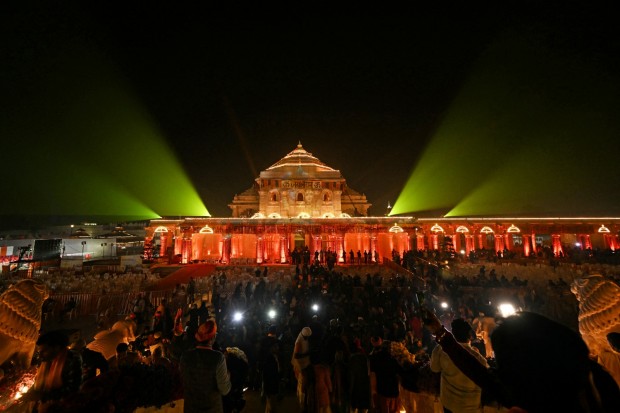The construction of the Ayodhya Ram Temple, which has been ongoing for 15 years, has now been finished. This structure, which cost more than $300 million, honors Indian customs and cultural expertise.

Inauguration of Ayodhya Ram Temple
On Monday, Jan. 22, a partial inauguration marked the opening of the grand temple dedicated to Lord Ram, a highly revered figure in Hinduism. The new international airport in Ayodhya, India, witnessed the arrival of around 80 privately arranged flights. People from around the country, including celebrities, athletes, businesspeople, politicians, and others, were present at the magnificent event, attended by approximately 7,000 VVIPs.
The Ram Mandir compound is built in the traditional Nagara architecture style and is meant to span 380 feet in the east-west direction. As mentioned, it has a width of 250 feet and an astounding height of 161 feet. Each of the floors of the temple's vertical structure is 20 feet in height, and they are held up by an impressive collection of three hundred and ninety-two pillars, which are detailed with 44 gates.
On the other hand, before attending the ceremony at Ayodhya on Jan. 22, Prime Minister Modi adhered to a stringent 11-day protocol known as 'anushthan.' he slept on the floor and consumed coconut water. A holy plunge was taken in the Rameswaram' Angi theerth' beach, and he also went to several temples all around India before the 'pran-pratishtha' ceremony performed at the Ram Mandir.
The streets of Ayodhya were filled with devotees praying in the sacred river and doing rituals as the ceremony occurred. This was happening outside of the complex of the temple. There were images of both men and women chanting religious slogans while carrying saffron flags and flower-adorned necklaces.
According to those who are opposed to Modi, a campaign that has been going on for decades to disassociate India from the secular foundations upon which the nation was established after it gained its independence has now come to an end,
Also Read: 7 Innovative and Energy-Efficient Building Projects Across the Globe
Construction of the Temple
The construction plan for Ahmedabad's master project, the Ram Temple, which was drawn up a decade ago, was designed by Chandrakant Sompura, a temple architect of the 15th generation. The mandir's construction is anticipated that 70% of the 70-acre total area will be covered in green forever.
Hindus that Ram, one of the most revered gods in the Hindu pantheon, was born at the very location in Ayodhya, and the temple would serve as the sacred dwelling place for Ram. Most people who embrace Hinduism have idols of Ram in their houses.
Millions of Hindus worship Lord Ram with the firm belief that repeating his name during times of difficulty will bring about peace and prosperity. Accordingly, the legendary stories of Ram, who extols the ideals of truth, sacrifice, and ethical administration, are central to celebrating major Hindu holidays such as Dussehra and Diwali.
As per Anil Mishra, a trust member who is in charge of supervising the construction, the temple was constructed without using iron, steel, or cement. He added that the temple combines traditional design with cutting-edge technology.
Related Article: Groundbreaking Milestone: Space Coast Launches Construction Its First-Ever 3D-Printed Home







